© Copyright Atlanta Coin Expositions, 2008-2025. All Rights Reserved.
Several of the links on the pages within this web site go to affiliate vendors.
A vendor affiliation can mean a small monetary compensation to the web site owner at no additional cost to you.
Several of the links on the pages within this web site go to affiliate vendors.
A vendor affiliation can mean a small monetary compensation to the web site owner at no additional cost to you.
Coin Show
Information
Shop
General
Next Monthly Coin Show
Coin Show - Monthly Notes for May 2021
Mark your calendar and join us at the next show on Sunday, June 13, 2021 in the Joe Mack Wilson ballroom.
Once again, dealers will spread across the bourse with their showcases filled with coins, currency, bullion, exonumia, scripophily, semi-precious stones, jewelry and other interesting items.
Visitors are welcome to the show whether buying, selling, trading or just looking at the many different historical items found at the show.
People can also bring items such as coins, currency and bullion to the show for the dealers to provide free verbal appraisals.
In the event circumstances impact the show, check with this web site, the recorded show message (770-772-4359) or join our mailing list to receive information about the shows.
Make a reminder note and visit the next Greater Atlanta Coin Show on Sunday, June 13, 2021 in the Joe Mack Wilson ballroom to buy, sell, trade or just browse among the many items on display.
Once again, dealers will spread across the bourse with their showcases filled with coins, currency, bullion, exonumia, scripophily, semi-precious stones, jewelry and other interesting items.
Visitors are welcome to the show whether buying, selling, trading or just looking at the many different historical items found at the show.
People can also bring items such as coins, currency and bullion to the show for the dealers to provide free verbal appraisals.
In the event circumstances impact the show, check with this web site, the recorded show message (770-772-4359) or join our mailing list to receive information about the shows.
Make a reminder note and visit the next Greater Atlanta Coin Show on Sunday, June 13, 2021 in the Joe Mack Wilson ballroom to buy, sell, trade or just browse among the many items on display.
Marcus Aurelius Denarius 161-180 AD
1882 Half Dollar Coin
1937 Five-Cent Coin
On a gorgeous day, many visitors joined the dealers at the May 2021 Greater Atlanta Coin Show to browse, buy, sell and trade among the showcases containing coins, currency, bullion and other collectible items.
As always, we appreciate all who help make the coin show a fun and busy place each month, from the many visitors to the dealers to our security and to the hotel's staff. Thank you one and all.
It was a beautiful May day with much less pollen, especially the nuclear yellow pine pollen, with partly cloudy skies and low humidity. Just a wonderful day with temperatures in the mid to upper 70s.
As always, we appreciate all who help make the coin show a fun and busy place each month, from the many visitors to the dealers to our security and to the hotel's staff. Thank you one and all.
It was a beautiful May day with much less pollen, especially the nuclear yellow pine pollen, with partly cloudy skies and low humidity. Just a wonderful day with temperatures in the mid to upper 70s.
We did have a few difficulties with the room set up this month. We appreciate the early attendees' patience as we maneuvered the tables and chairs to fix the issues.
We also appreciate dealers' patience and assistance re-configuring the room.
As for the show attendees, people continued to search for gold and silver. Many want the metals as a hedge against the expected inflation while others want the eye-catching items for their collections.
We also appreciate dealers' patience and assistance re-configuring the room.
As for the show attendees, people continued to search for gold and silver. Many want the metals as a hedge against the expected inflation while others want the eye-catching items for their collections.
In their showcases, the dealers provide an interesting and wide variety of precious metals in addition to rare and collectible coins and currency for people looking to increase or upgrade their collections.
Now, let's take a look at just a few items located on the bourse.
Now, let's take a look at just a few items located on the bourse.
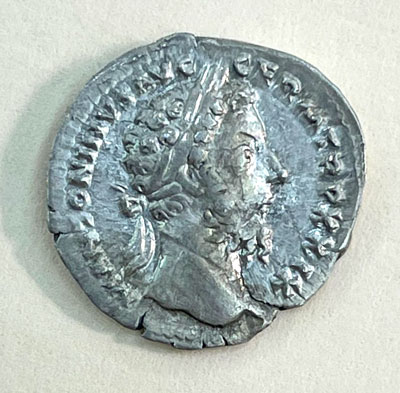
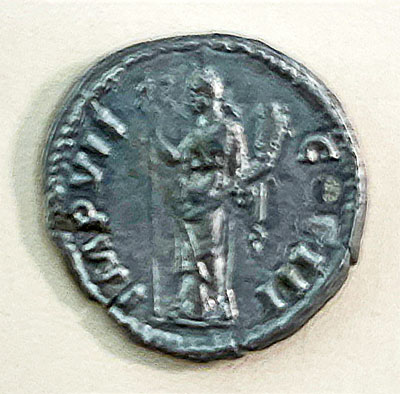
From MONETA, at www.numus.com:
"MARCVS AELIVS AVRELIVS VERVS, born Marcus Annius Verus in 121 at Rome to Domitia Lucilla and Annius Verus, had his name changed when he was adopted by his uncle Antoninus Pius in 138.
"He married Faustina Jr. in 145, and became Augustus after Pius died on March 7, 161.
"He then made Lucius Verus his co-ruler. Aurelius' reign was one of constant warfare, most of which he personally directed after 167 (Verus died in 169).
"He had nearly achieved total victory along the Danube when he died at Vienna on March 17, 180 after a brief illness. He was deified and buried in Hadrian's Tomb."
Similarly, another resource (scottishantiques.com) provides more history:
"MARCVS AELIVS AVRELIVS VERVS, born Marcus Annius Verus in 121 at Rome to Domitia Lucilla and Annius Verus, had his name changed when he was adopted by his uncle Antoninus Pius in 138.
"He married Faustina Jr. in 145, and became Augustus after Pius died on March 7, 161.
"He then made Lucius Verus his co-ruler. Aurelius' reign was one of constant warfare, most of which he personally directed after 167 (Verus died in 169).
"He had nearly achieved total victory along the Danube when he died at Vienna on March 17, 180 after a brief illness. He was deified and buried in Hadrian's Tomb."
Similarly, another resource (scottishantiques.com) provides more history:
Our first coin is an ancient denarius with Marcus Aurelius on the obverse.
He was known as the philosopher and reigned from 161 to 180 AD.
He was known as the philosopher and reigned from 161 to 180 AD.
This particular coin shows "M ANTONINVS AVG GERM TR P XXIX" with Laureate head right on the obverse. The reverse includes "IMP VII COS III" with Felicitas standing holding a caduceus in the right hand and a cornucopia in the left.
At not quite 2000 years old, this silver coin represents significant history from Roman rule to the modern day.
At not quite 2000 years old, this silver coin represents significant history from Roman rule to the modern day.
1861 Three-Cent Coin
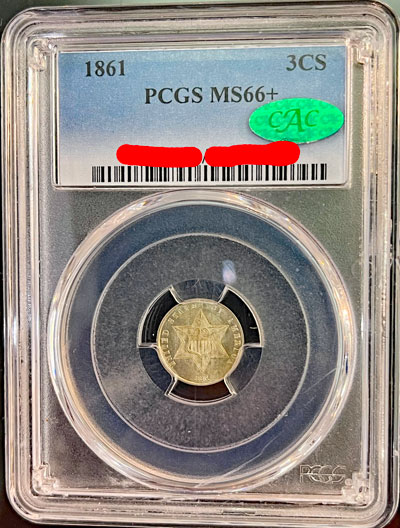
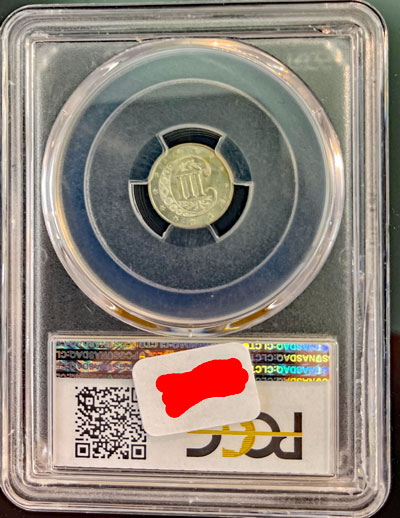
The artist, James B. Longacre, described his design for the coin in a letter to Treasury Secretary Thomas Corwin on March 2,1851:
"On so small a coin it is impossible that the device can be at once conspicuous and striking unless it is simple-complexity would defeat the object.
"For the obverse I have therefore chosen a star (one of the heraldic elements of the National crest) bearing on its centre the shield of the Union, surrounded by the legal inscription and date.
"For the reverse I have devised an ornamental letter C embracing in its centre the Roman numeral III, the whole encircled by the thirteen stars."
"On so small a coin it is impossible that the device can be at once conspicuous and striking unless it is simple-complexity would defeat the object.
"For the obverse I have therefore chosen a star (one of the heraldic elements of the National crest) bearing on its centre the shield of the Union, surrounded by the legal inscription and date.
"For the reverse I have devised an ornamental letter C embracing in its centre the Roman numeral III, the whole encircled by the thirteen stars."
Our next specimen is a tiny American coin dated 1861 struck of silver and represented three cents of monetary value.
Some people call this a "trime" while others liken its appearance to a "fish scale."
The US Mint produced the silver three-cent coins in the years 1851-1873 while they also made nickel three-cent coins of a different design from 1865-1889.
Some people call this a "trime" while others liken its appearance to a "fish scale."
The US Mint produced the silver three-cent coins in the years 1851-1873 while they also made nickel three-cent coins of a different design from 1865-1889.
Again, the coin is very small not only in diameter but also in thickness.
During the first three years, the coin weighed 0.80 gram and consisted of 75% silver and 25% copper with a diameter of 14 mm.
In 1854, the content changed to 90% silver and 10% copper with a weight of 0.75 gram or 0.024 troy ounce.
The diameter of 14 mm stayed the same, which is just over one half of an inch.
Except for some coins minted in New Orleans in 1851, the Philadelphia Mint struck the silver three-cent coins from 1851-1873.
During the first three years, the coin weighed 0.80 gram and consisted of 75% silver and 25% copper with a diameter of 14 mm.
In 1854, the content changed to 90% silver and 10% copper with a weight of 0.75 gram or 0.024 troy ounce.
The diameter of 14 mm stayed the same, which is just over one half of an inch.
Except for some coins minted in New Orleans in 1851, the Philadelphia Mint struck the silver three-cent coins from 1851-1873.
"The PCGS Condition Census contains a full complement of MS67 examples, meaning that collectors can find some wonderful examples on the market. The 1861 usually comes well struck, seldom with clashmarks, and often with rich, frosty luster. For type purposes, this is a great date, and one that offers excellent value."
This small coin is an interesting and fun addition to any numismatic collection.
This small coin is an interesting and fun addition to any numismatic collection.
"Marcus Aurelius was the last of a series of emperors of Rome known as the 'Five Good Emperors'; bringing peace and stability, the 'Pax Romana.'
"He was born in AD 121 and died in 180. As a person of studious disposition, he was a dedicated student of languages and became a great philosopher. This caused him much consternation when he was expected to follow all the pomp of the royal court.
"On the death of Antoninus Pius in 161 he was 'compelled' to take imperial office and reluctantly did so, in fact he said he would only take the throne if Lucius Verus ruled with him equally. This was the first time there had ever been two emperors at the same time."
"He was born in AD 121 and died in 180. As a person of studious disposition, he was a dedicated student of languages and became a great philosopher. This caused him much consternation when he was expected to follow all the pomp of the royal court.
"On the death of Antoninus Pius in 161 he was 'compelled' to take imperial office and reluctantly did so, in fact he said he would only take the throne if Lucius Verus ruled with him equally. This was the first time there had ever been two emperors at the same time."
In 1861, the Mint produced 497,000 of the small silver coins.
PCGS (Professional Coin Grading Service) graded this example as MS66+, and per their population report, this is just one of eight coins to receive that grade.
Per Ron Guth on the PCGS web site:
"The 1861 Three Cent Silver has the highest mintage of any date in the 1860s, but this is a relative term, since the 1852 (the most common date in the series) has a mintage that is 375 times that of the 1861. This disparate relationship does not translate to the PCGS Population Report, where the census of the 1852 is only twice that of the 1861, but this is due to the fact that most circulated examples never make it to the grading services.
PCGS (Professional Coin Grading Service) graded this example as MS66+, and per their population report, this is just one of eight coins to receive that grade.
Per Ron Guth on the PCGS web site:
"The 1861 Three Cent Silver has the highest mintage of any date in the 1860s, but this is a relative term, since the 1852 (the most common date in the series) has a mintage that is 375 times that of the 1861. This disparate relationship does not translate to the PCGS Population Report, where the census of the 1852 is only twice that of the 1861, but this is due to the fact that most circulated examples never make it to the grading services.
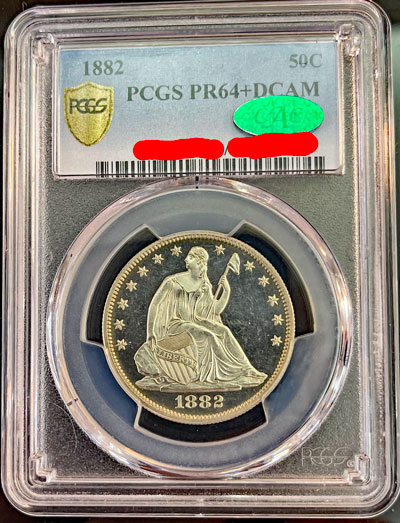
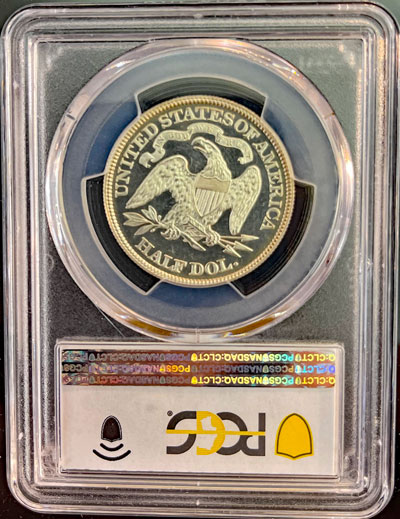
In the 1800s, the US Mint made many coins with a Liberty Seated design from the half dime to the dime to the twenty-cent piece to the quarter to the half dollar and to the dollar coins.
The designs are not the same, however they all featured a version of Liberty Seated on the obverse of the coins.
For the Liberty Seated half dollar coin, Thomas Sully and Christian Gobrecht developed the design.
Over the period, 1839-1891, the US Mint struck several slightly different varieties of the coin along with changing the weight of the coin a couple of times as well.
In 1882, the Philadelphia Mint produced 1100 proof Liberty Seated half dollar coins and 4400 circulation strike coins for a total of just 5500 pieces in that year.
This particular year utilized Variety 4 of the designs with the weight standards associated with Variety 5.
On the PCGS web site, Ron Guth commented:
The designs are not the same, however they all featured a version of Liberty Seated on the obverse of the coins.
For the Liberty Seated half dollar coin, Thomas Sully and Christian Gobrecht developed the design.
Over the period, 1839-1891, the US Mint struck several slightly different varieties of the coin along with changing the weight of the coin a couple of times as well.
In 1882, the Philadelphia Mint produced 1100 proof Liberty Seated half dollar coins and 4400 circulation strike coins for a total of just 5500 pieces in that year.
This particular year utilized Variety 4 of the designs with the weight standards associated with Variety 5.
On the PCGS web site, Ron Guth commented:
The next coin is a Liberty Seated half dollar coin minted in 1882.
PCGS graded this coin as PR64+DCAM or Proof 64+ Deep Cameo.
PCGS graded this coin as PR64+DCAM or Proof 64+ Deep Cameo.
"The 1882 Half Dollar is very scarce as a Proof due to its low mintage of only 1,100 pieces. This number is not particularly small for coins of that period, but it is low when compared to the millions of Proofs that are being produced today.
"What makes this coin especially valuable is the small mintage of only 4,400 circulation strikes, which means that collectors who seek high-grade examples of this date are often forced to consider purchasing a Proof in light of the scarcity of Mint State pieces.
"In this year, Cameo Proofs represented a higher percentage of the total population and finally, Deep Cameos begin to appear with increasing frequency -- though they are still quite scarce.
"The overall quality of Proof Half Dollars from this year is excellent, indicating that most were set aside and carefully preserved by prescient collectors."
Today, the PCGS population report shows only one coin graded as PR67+ with just thirteen graded higher with the Deep Cameo designation.
"What makes this coin especially valuable is the small mintage of only 4,400 circulation strikes, which means that collectors who seek high-grade examples of this date are often forced to consider purchasing a Proof in light of the scarcity of Mint State pieces.
"In this year, Cameo Proofs represented a higher percentage of the total population and finally, Deep Cameos begin to appear with increasing frequency -- though they are still quite scarce.
"The overall quality of Proof Half Dollars from this year is excellent, indicating that most were set aside and carefully preserved by prescient collectors."
Today, the PCGS population report shows only one coin graded as PR67+ with just thirteen graded higher with the Deep Cameo designation.
PCGS has highly graded other Liberty Seated proof half dollar coins with over one hundred coins in proof, cameo proof, or deep cameo proof as a 64+ or higher grade.
This particular coin has maintained its characteristics for a lot of years.
This particular coin has maintained its characteristics for a lot of years.
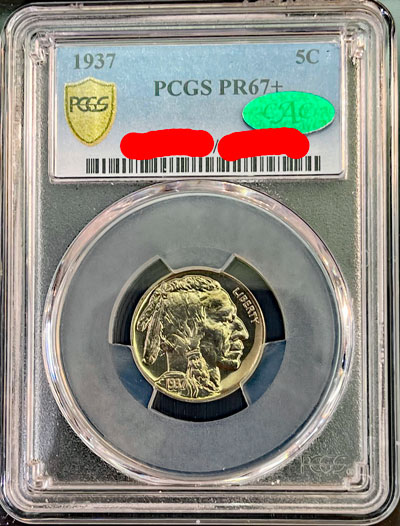
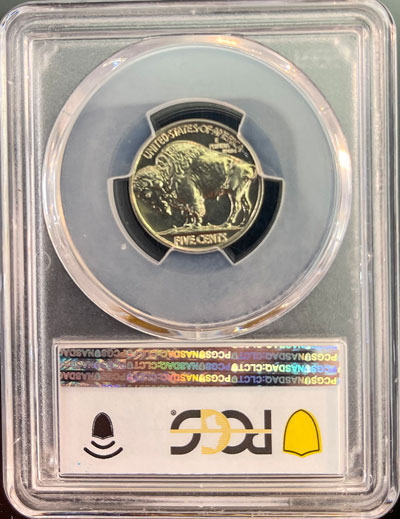
The next coin is an Indian Head or Buffalo Five-Cent Coin struck by the Philadelphia Mint in 1937 as a proof coin.
The Mint produced 5,769 of the proof five-cent coins in that year.
James Earle Fraser designed the coin utilizing three different Native Americans for the obverse and "Black Diamond" of the New York Central Park Zoo for the bison on the reverse.
The US Mint used this design with some slight modifications for the five-cent coins from 1913-1938 when the Jefferson nickel was introduced.
Currently, the PCGS population report estimates 5,000 of the proof coins still exist with 3,666 of those in grades proof 65 or better.
This example in PR67+ is one of 96 PCGS has graded at that particular level.
The Mint produced 5,769 of the proof five-cent coins in that year.
James Earle Fraser designed the coin utilizing three different Native Americans for the obverse and "Black Diamond" of the New York Central Park Zoo for the bison on the reverse.
The US Mint used this design with some slight modifications for the five-cent coins from 1913-1938 when the Jefferson nickel was introduced.
Currently, the PCGS population report estimates 5,000 of the proof coins still exist with 3,666 of those in grades proof 65 or better.
This example in PR67+ is one of 96 PCGS has graded at that particular level.
They have also graded 59 1937 proof five-cent coins in the higher grades of PR68, PR68+ or PR69.
For a PR67 designation, the Official ANA Grading Standards states:
"Has full mirror (or other style Proof) surface and sharp strike for the variety. May have three or four very small contact marks and one more noticeable but not detracting mark. A few hairlines may show under magnification, or one or two partially hidden scuff marks or flaws may be present. Eye appeal is exceptional."
With this coin's "plus" label, it has better than the PR67 characteristics but not quite as good as a PR68 coin.
This 1937 Five-Cent Coin provides a nice representation of the Indian Head or Buffalo coin.
For a PR67 designation, the Official ANA Grading Standards states:
"Has full mirror (or other style Proof) surface and sharp strike for the variety. May have three or four very small contact marks and one more noticeable but not detracting mark. A few hairlines may show under magnification, or one or two partially hidden scuff marks or flaws may be present. Eye appeal is exceptional."
With this coin's "plus" label, it has better than the PR67 characteristics but not quite as good as a PR68 coin.
This 1937 Five-Cent Coin provides a nice representation of the Indian Head or Buffalo coin.
2021 Australian Koala Silver Dollar Coin
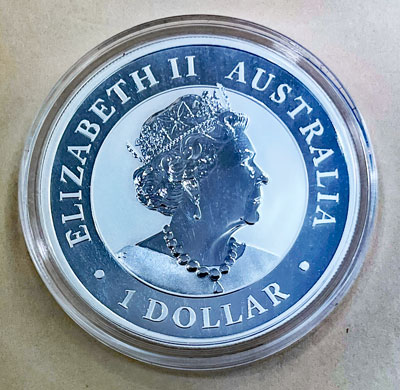
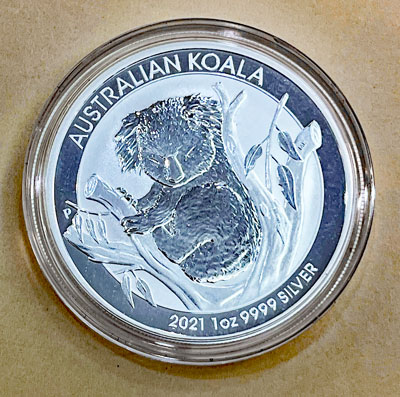
Our next specimen and the last for this month comes from the Perth Mint in Australia. It's the 2021 Australian Koala Silver Dollar Coin.
Similar to the American Silver Eagle coins, the Australian Koala contains one ounce of silver and has a legal tender value of one Australian dollar.
However, the coin's metal content makes it worth more than its face value.
Beginning in 2007, the Perth Mint introduced the Koala series of bullion coins. Each year, they feature a new Koala design that uniquely represents Australia.
The Perth Mint produces Australian Silver Koala coins in both 1 oz and 1 kilogram size, with the mintage of the 1 oz size capped at just 300,000 coins.
Similar to the American Silver Eagle coins, the Australian Koala contains one ounce of silver and has a legal tender value of one Australian dollar.
However, the coin's metal content makes it worth more than its face value.
Beginning in 2007, the Perth Mint introduced the Koala series of bullion coins. Each year, they feature a new Koala design that uniquely represents Australia.
The Perth Mint produces Australian Silver Koala coins in both 1 oz and 1 kilogram size, with the mintage of the 1 oz size capped at just 300,000 coins.
This makes the Australian Silver Koala one of the most collectible bullion series.
The Koala, along with the Kookaburra, Lunar Series, and Kangaroo form what has continued to be a robust line of high quality bullion products from the Perth Mint of Australia.
The koala is an herbivore native to Australia and is referred to as a “koala bear”, however koalas are not bears at all, they are marsupials.
Koalas climb trees and have a pouch to carry their offspring, similar to kangaroos.
Koalas have special physical characteristics that complement their tree-dwelling lifestyle. They're able to grip branches and pick eucalyptus leaves with their two opposable digits. Their tough skin and sharp claws provide traction in climbing.
The Koala, along with the Kookaburra, Lunar Series, and Kangaroo form what has continued to be a robust line of high quality bullion products from the Perth Mint of Australia.
The koala is an herbivore native to Australia and is referred to as a “koala bear”, however koalas are not bears at all, they are marsupials.
Koalas climb trees and have a pouch to carry their offspring, similar to kangaroos.
Koalas have special physical characteristics that complement their tree-dwelling lifestyle. They're able to grip branches and pick eucalyptus leaves with their two opposable digits. Their tough skin and sharp claws provide traction in climbing.
Unfortunately, this animal is one of the most impacted by deforestation, wildfires, and other environmental changes.
The obverse displays the Jody Clark portrait of Her Majesty Queen Elizabeth II and is inscribed with her name, the country's name, and the denomination.
The new design for the 2021 Silver Koala Coin's reverse features the koala sleeping as the branches of a eucalyptus tree cradle it. Inscriptions on this side note the coin’s year of issue, the weight, the purity, program name, and Perth Mint "P" Mintmark.
This silver bullion coin certainly represents the beauty and uniqueness from the land down under.
The obverse displays the Jody Clark portrait of Her Majesty Queen Elizabeth II and is inscribed with her name, the country's name, and the denomination.
The new design for the 2021 Silver Koala Coin's reverse features the koala sleeping as the branches of a eucalyptus tree cradle it. Inscriptions on this side note the coin’s year of issue, the weight, the purity, program name, and Perth Mint "P" Mintmark.
This silver bullion coin certainly represents the beauty and uniqueness from the land down under.
